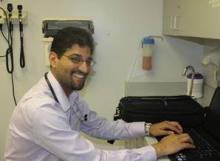So far, the Centers for Medicare and Medicaid has touted the "carrots" associated with the use of health information technology. Come June 30, it will start using one of its first "sticks."
Physicians have until June 30 to report on the use of electronic prescribing under Medicare Part B or apply for a hardship exemption. Those who fail to do either face a 1.5% reduction in their Medicare payments starting on Jan. 1, 2013.
The e-prescribing requirement is not difficult to achieve by itself. Instead, it is one more burden faced by physicians who are already trying to find the time and money to manage Medicare requirements related to the meaningful use of health information technology and quality reporting, according to Neil Kirschner, Ph.D., senior associate for regulatory and insurer affairs at the American College of Physicians.
For those who aren’t already e-prescribing, the decision will be whether to find an inexpensive e-prescribing program and submit the information necessary to avoid the penalty, or to invest in the transition to a full-scale electronic health record (EHR) system.
For a typical physician with a 2,000-patient panel whose practice is 40% Medicare, the 1.5% penalty could add up to $3,000 to $4,000 in 2013, Dr. Kirschner said.
Dr. Mary Newman, an internist in Lutherville, Md., isn’t worried about the e-prescribing penalty. Her multispecialty practice has been e-prescribing since 2005, and they’ve been doing it as an integrated part of their EHR system since 2007. She writes paper prescriptions just a couple times a month now.
Dr. Newman said she wouldn’t go back to paper prescribing. E-prescribing is better and safer, she said. With consent from her patients, she now can see medications prescribed by her patients’ other physicians. It helps prevent double prescribing, misprescribing, and drug interactions, she noted. There also is less time spent on the phone with the pharmacy. In addition, the electronic system helps improve documentation and record keeping, Dr. Newman said.
But while the system is virtually seamless today, Dr. Newman said she and her colleagues first approached the idea with "trepidation and aggravation."
"Especially for primary care, we’re so busy, it’s very threatening to make any kind of change," she said.
Dr. Jasdip Brar, an internist in Glendale Heights, Ill., jumped right into e-prescribing through his EHR system, but has struggled since.
Last year, Dr. Brar thought he was well on his way to successful e-prescribing through the Medicare Electronic Prescribing (eRx) Incentive Program when he got a letter from CMS stating that Medicare was cutting his payments by 1% in 2012 for failure to use e-prescribing.
It turns out that the EHR, which had come free with his billing system, never sent the appropriate G codes. He’s still waiting to hear from CMS if it will accept his backup documentation as proof of e-prescribing.
"My experience has been kind of rough," Dr. Brar said.
This year, he said that he has switched to a different free EHR system and is being more vigilant about ensuring CMS receives his codes.
But regardless of what happens with the payments, Dr. Brar said he’s dissatisfied with the electronic products on the market and the requirement that he must e-prescribe.
Dr. Brar, who opened a hybrid concierge practice about a year and a half ago, said he’s still much faster when writing prescriptions by hand. When he uses the EHR, it’s as if he’s being turned into a "point-and-click data entry clerk," he said, and it’s not how he wants to spend his time.
"It really becomes frustrating when you’re spending more time dealing with a computer than you are the patient," Dr. Brar said.
Despite the obstacles, a majority of physicians are engaged in e-prescribing, according to a new report from Surescripts, which operates the nation’s largest health information network.
By the end of 2011, 58% of U.S. office-based physicians had adopted e-prescribing, compared with about 10% of physicians 3 years earlier.
That rapid adoption trend is likely to continue, according to Seth Joseph, director of strategy and innovation at Surescripts and the lead researcher on the report. The federal dollars available through the Medicare and Medicaid EHR incentive programs appear to be one of the driving forces behind the uptick in adoption, he said.
As a result, many physicians are starting to see the use of EHRs and e-prescribing technology as inevitable and a standard of care, he said. Another important factor is the development of less expensive, "cloud-based" EHR products, which are making a comprehensive electronic system a more reasonable investment even in smaller practices, Mr. Joseph said.



